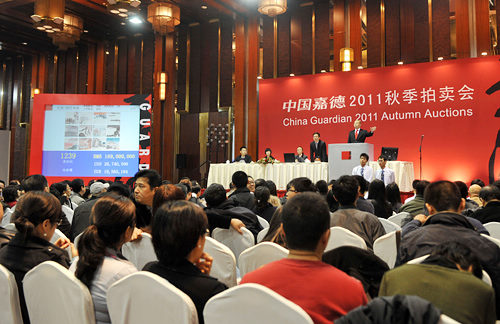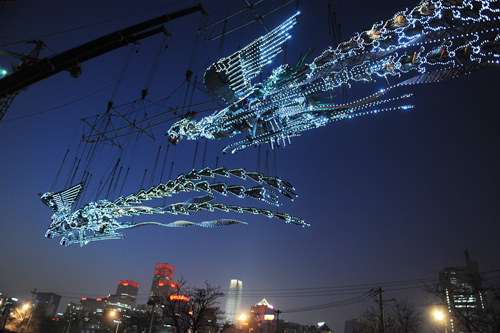|
 |
|
NEW RECORD: Landscape Painting Album by contemporary Chinese artist Qi Baishi is sold for 194 million yuan ($30.31 million) at the China Guardian 2011 Autumn Auction on November 13 (CFP) |
"In the 1980s, we still called it the art world, but now we call it the art market," said Eric Fischl, an internationally acclaimed American painter and sculptor at a panel on the relationship between the arts and the marketplace during the U.S.-China Forum on Arts and Culture last month.
"In the early days of my generation of artists, our fame and fortune were not connected. We were not tied to the prevailing market direction. There was a school of people who were immensely famous within the art world but making a living by teaching and renovating. The fortune part was not at all connected to the degree of fame they had," said Fischl.
To his surprise, from the 1980s onwards, his artwork began to sell for rapidly increasing prices. "The change was dramatic—the system became totally different," said Fischl.
In many other countries, the art world followed a similar course toward commercialization; the process occurred later in China, but at much higher speed. Contemporary Chinese artist Liu Xiaodong witnessed the process in the past 10 years.
From the late 1980s to 2004, the price of contemporary artwork didn't exceed 100,000 yuan ($15,625). "But after 2004, the price exploded, and much more money flowed into the market at a much higher speed than we expected," Liu said.
Liu's painting The Three Gorges Project sold for 22 million yuan ($3.44 million) in 2006.
"It was crazy. I got endless calls every day asking me whether it was really worth the money or not," said Liu, who has struggled to understand the price his work was sold for. "Nobody ever expected the price of contemporary artwork could rocket from tens of thousands to tens of millions yuan in less than two years."
 |
|
FLYING IN THE SKY: A sculpture named Phoenix created by Xu Bing is shown in the Today Art Museum in Beijing on March 27, 2010 (HU QINGMING) |
"As artists we then had to face a question that we didn't even want to talk about before—money. How to deal with the money that was suddenly showered on us?" said Liu.
"We know that the art market is now well developed and is in fact a huge industry. But I've never known an artist who really wants to talk about the marketplace," said Melissa Chiu, Director of the Asia Society Museum in New York.
"Artists are always reticent to talk about money and business, because we know that artistic merit and market value are not the same, most of the time," said Liu. "My opinion is that while it's fine to trade artwork for money, we can't make works for money, or effectively make money the objective of our work."
"I agree with Liu," said Xu Bing, another well-know contemporary Chinese artist and Vice President of the China Central Academy of Fine Arts. "Almost everything now is directed by the market, so we can't ignore this. We should take a positive attitude to this."
In the 1980s, Xu created A Book From the Sky, which was displayed in the China Art Gallery in Beijing in 1988. The sculpture, which consisted of a set of books, panels and scrolls featuring thousands of characters resembling real Chinese characters, was a big hit in the Chinese art community.
"My works are not really suitable for collection as they take up a lot of space. But there are still people willing to buy and keep them," said Xu. "Basically they are just wood and paper. Why do people pay so much money for them? I think it is because they discover a new way or a new angle to observe the world, or because they see some emotion in the artworks which touches them."
"I don't know any artist who doesn't make work out of love. The weird thing about the art market is that you make work for love, but somebody gives you money," said Fischl. "Money is a neutral thing. It is the way we use it that makes difference."
Liu spends most of the money he receives from selling his artworks on holding exhibitions and investing in movies that have some connection to his paintings. He funded the movie Still Life, which describes the lives of people who were forced to move as a result of the Three Gorges Project. Jia Zhangke, director of the movie, was inspired by his painting and the film went on to win the Golden Lion award at the Venice Film Festival in 2006.
"Chinese contemporary artworks are worth more and more on the international art market today. I think one of the major factors behind the demand for these pieces is that China has drawn more attention internationally," said Xu. "I think people are interested in learning about China from the work—it's a way of trying to understand contemporary Chinese society and culture."
Liu echoed this sentiment by revealing that his inspiration comes mostly from the social changes he has witnessed or participated in. "We are living in a complicated era and I show many social tensions in my works, such as changes in my hometown, the bankruptcy of state-owned factories. We have the responsibility to record the changes as participants, not simply as outsiders." | 